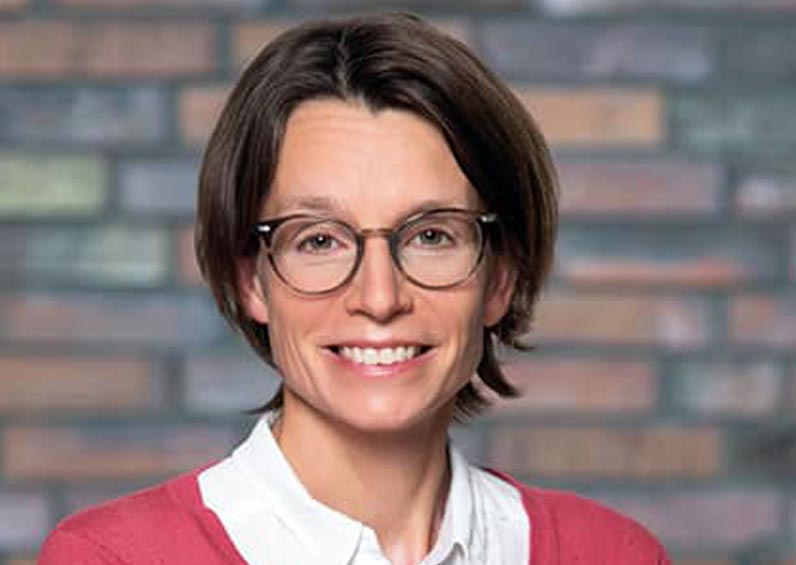

Frauke Gräter
(Photo: HITS)
– the molecular biomechanics of collagen.
HITS researcher Frauke Gräter receives an HFSP Research Grant Award for a project on a novel form of mechanosensing. Together with colleagues from Israel and USA, she investigates the effects of physical force on the collagen protein in two different animal model systems. Their goal is to measure the effects of mechanoradicals on the integrity of the tissue and the well-being of the organism, with impact on health and aging.
As we move around in the world, our body is often exposed to forces such as squeezing and stretching. This is true also at the cellular level. Mechanobiology studies how cells can sense and respond to mechanical forces. A major challenge in this field is to elucidate the molecular mechanisms that allow cells to sense forces. So far, research has been focused a lot on structures within cells, such as the cytoskeleton and cell adhesions.
HITS group leader Frauke Gräter has been thoroughly investigating the mechanobiological properties of collagen, with in silico and in vitro methods. Together with her colleagues Ronen Zaidel-Bar (Tel Aviv University, Israel) and Alexander Dunn (Stanford University, USA), she wants to explore the space outside the cell, often filled with collagen, and uncover its signaling into the cell. For their proposal to the Human Frontier Science Program (HFSP), the three researchers received an HFSP Research Grant Award 2024. The project will start on 1 July 2024, with about $1.5 million USD funding for three years.
The (mechano)radical quest: comparing worms and mice
“The novel idea behind this proposal is that proteins outside of the cell can also be affected by force and generate diffusible chemical signals that can reach nearby cells and influence their function”, Frauke Gräter explains. In their recent observations they found that in controlled lab conditions, stretching extracellular protein collagen causes rupture of chemical bonds that release free radicals. “Our goal is to prove that this process happens also in living tissues under normal physiological forces and to study the impact of mechanoradicals on the health of the tissue and the entire organism”, Alexander Dunn, a molecular biologist and expert in tissue engineering from Stanford University, adds.
To this end, the researchers will use two model systems: a tendon taken from a mouse and the worm Caenorhabditis elegans. Tendons are highly collagenous tissue that connects muscles to bones and can be cultured outside of the animal for several days. C. elegans is a powerful genetic model system and its exoskeleton is made nearly entirely of collagen. “But the collagen of C. elegans has a different, still unknown structure,”, says Ronen Zaidel-Bar, a cell and development biologist and C. elegans expert from Tel Aviv University.
The researchers will employ a combination of cutting-edge techniques and try to measure the effect of mechanoradicals on the integrity of the tissue and the well-being of the organism, including its fertility, resilience to stress, and lifespan. “Eventually, we will uncover mechanoradicals as a previously unrecognized molecular species in life that converts tension into physiological responses with implications for health, disease, and aging”, Frauke Gräter resumes.
HFSP Research Grant Awards
For 2024, HFSP has chosen to support 34 Research Grant project teams that include 108 scientists representing 23 nations. Their projects span 10 areas of the life sciences that range in focus from the most molecular science to cross-disciplinary investigations that span biomes. Each grant will last for three years and on average, each award is for $400,000 USD per year. https://www.hfsp.org/
This project is supported by a Research Grant from HFSP (Ref.-No: RGP025/2024).
Scientific contact:
Frauke Gräter
Molecular Biomechanics group
Heidelberg Institute for Theoretical Studies (HITS)
Press contact:
Peter Saueressig
Head of Communications
Heidelberg Institute for Theoretical Studies (HITS)
Wissenschaftliche Ansprechpartner:
Frauke Gräter
Molecular Biomechanics group
Heidelberg Institute for Theoretical Studies (HITS)
https://www.h-its.org/people/prof-dr-frauke-grater/
Weitere Informationen:
https://www.h-its.org/2024/05/21/hfsp_award_graeter/ HITS press release












